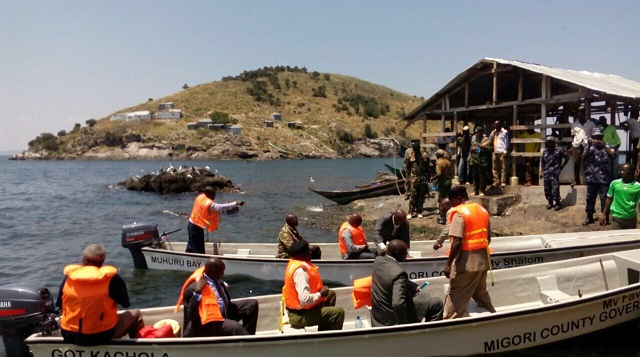
What dispute over the world’s tiniest disputed island, tells us about international law
COMMENT | CHRISTOPHER R. ROSSI | For as far back as anyone could remember, Migingo was nothing more than an uninhabited pinprick on Lake Victoria. One of three small islands in the eastern waters that make up an island chain, Migingo is barely the size of half a football pitch. It measures about one-half acre or about two thousand square metres.
In 2001 resourceful fishermen began using Migingo as an offshore weigh station. The islet just happened to be more habitable than the steeply sloped adjoining islets. And because the fishermen earned three to four times in a day what shore-based fishermen could earn in a month, word soon spread that Migingo’s geographic location made it ideally suitable to hunt the Nile perch.
The Nile perch, locally known as mbuta, is one of the most invasive and best studied species in history. This devastating piscavore, probably introduced by Uganda in the 1950s, is rapidly turning Lake Victoria into an Anthropogenic problem. But there is no doubting the economic value it generates as a much sought-after dinner item in European restaurants and in expanding worldwide markets.
The islet quickly became a micro slum, housing hundreds of people, including pirates and smugglers. It also sparked for the first time competing claims by Uganda and Kenya over who owns Migingo. Both countries claim it is theirs.
The debate about Migingo’s fate has been fuelled by the perceived imbalance in the Nile perch trade – Kenya owns 6% of Lake Victoria but dominates the perch trade while Uganda owns 43% but harvests less than half of Kenya’s catch. An added complication was the 2006 discovery of commercially viable oil deposits across the East African Rift System. An oil find could potentially straddle the disputed demarcation line.
The dispute has become intractable, despite bilateral and multilateral discussions. A series of aggressive encounters between Ugandan marines and Kenyan police have brought the parties to the brink of violence while eight years ago Kenyan rioters uprooted landlocked Uganda’s rail link to the Kenyan port of Mombasa. This disruption in turn affected the commercial interests of, among others, Rwanda, Burundi and eastern Democratic Republic of Congo.
Characterisations of the dispute as small do no justice to the importance of the international legal issues at play. Migingo intertwines issues of ethnicity, nationality, and politics around the competing temptations of a resource. But it also serves as an example of the lingering effects of uti possidetis, a principle of international law, which provides that newly formed sovereign states should have the same borders that their preceding dependent area had before their independence.
This principle reinforced the work of British imperial line drawers who reshaped the landscape of this region through cartographic shortcuts and a 1926 British Order in Council.
A brutal principle
Uti possidetis has been described as an important building block of the state system. This is because it emphasises stability, finality, and respect for territorial borders. The World Court places it among the most important legal principles.
But it is a brutal principle. It requires that states emerging from decolonisation essentially inherit the borders they received at the time of independence. The presumption is that territorial title freezes, like a photographic snapshot, at the moment of independence, regardless of how arbitrary the borders may be.
Migingo’s problem boils down to a difference of opinion between Uganda and Kenya about the ‘snap shot’ used to draw the line demarcating the border. Add to this the fact that the British took the photo a long time ago, and its camera may have been out of focus.
Out of focus or not, the international doctrine aided the project of African statecraft by settling, or at least forestalling, disputes over porous borders. It allowed African elites to consolidate power. Indeed it has informed the Charter of the Organisation of African Unity, the African Union’s Constitutive Act, and the 1964 OAU Cairo Declaration.
But the costs associated with this blunt instrument of international law remain substantial. It leaves Africa with a forced coincidence of borders among many states. Africa’s tiniest border dispute of Migingo is a metaphor for the pressures now associated with areas of conflict affecting Africa’s great hydrographic catchments.
Colonial cartography, like the entire nineteenth century Scramble for Africa begun at the Berlin Conference, was done with little regard for human geographies or the overlapping realities.
Even more problematic was the decision taken later by the British to remove the Eastern Province of the Ugandan Protectorate to the East African Protectorate. This placed a huge portion of the Rift Valley in what would become Kenya. The rationale for this line drawing was to keep within one administrative jurisdiction the 960km railway connecting Mombasa on the Indian Ocean to the northeast corner of Lake Victoria. But inserting a geographic line of convenience to accommodate railroad administration created a human geographic chaos of its own.
Where the line falls
Some evidence suggests that Migingo was the generic name of the undifferentiated island chain which only later differentiated the two other islets. These are Ugingo, which lies 660 feet east of Migingo, and Pyramid Island, 2km south of Migingo. Ugandan surveyors claim that Ugingo is actually Pyramid Island, because it is shaped like a pyramid. This finding would put Migingo inside Uganda by a matter of meters.
Uganda’s President Yoweri Museveni was said to have suggested that Migingo was located in Kenya’s water but he claims he was misquoted. Even if this were indisputably so, much of the Kenyan catch of Nile perch may derive from illegal fishing activity in Ugandan waters.
Evidence suggests the perch breed off Kenya’s shallow littoral and migrate into deeper waters around Migingo. Where the line falls between Uganda and Kenya in Lake Victoria will have little effect on the need for a managed solution. This would necessarily also involve Tanzania, and require cooperation, which is lacking.
Problems facing the Lake Victoria catchment directly affect the livelihood of 30 million people. Efforts to promote the sustainable development of the lake now involve an array of international organisations, specialised institutions of the East African Community, and Rwanda and Burundi as part of a more sensitive environmental understanding of the lake catchment region.
The small geographic size of the Migingo dispute belies the grave political consequences of inaction, making Migingo a metaphor for African resolve in the Anthropocene.
*****
Christopher R. Rossi is a Lecturer in international law, University of Iowa. His in depth analysis of the Migingo dispute has just been published in the Brooklyn Journal of International Law.
Source: theconversation
 The Independent Uganda: You get the Truth we Pay the Price
The Independent Uganda: You get the Truth we Pay the Price




To a Naturalist and pan Africanist, several points stand out in this article.
1. Man – made ‘Law’ – whether local or international – needs regular revision to match circumstances of the times
2. Africans – or rather their ‘independence’ leaders – made a strategic mistake to ‘blindly’ accept colonial masters’ borders
3. Post independence African leaders and elites are essentially today’s ‘Africa’s curse’ in so far as they fail to correct their forefathers’ mistakes – (and some even continue to demand further subdivision of the continent)
4. The land where all Africans are naturally free to roam, work, mingle, develop, and settle was clearly demarcated by Natural processes: it stretches from the Indian ocean in the East to the Atlantic in the west. And for black Africans, it stretches from the fringes of the Sahara (roughly Tropic of Cancer) to the Cape. That is one block of a ‘country’ which our ancestors used to ‘freely’ migrate in. With so called ‘civilisation’ or ‘modernisation’ we should be working for its consolidation as one political entity, but not this stupidity of ‘quarreling’ over small pieces of land and the few natural resources (which by the way – our small enclaves prevent us from meaningfully exploiting) therein.
5. Some times one wonders whether Man’s so called superior ‘intelligence’ is worth what we think it to be: Fish in the lake know where best to breed and where best to reside after breeding. Man says they are ‘born’ in Kenya but are Ugandan. What logic is this? Same with the Masai – Mara animal migrations. Particularly these two, should be testing the intelligence of East African elites and their present leaders. Museveni, Kenyatta, Magufuli: what do you have to say? Please do not hide in ‘our people have to decide and agree’. You have the greatest influence on whether we correct the Obote-Kenyatta (Sen)-Nyerere mistakes. Stand out now and be counted among True African intelligent patriots!